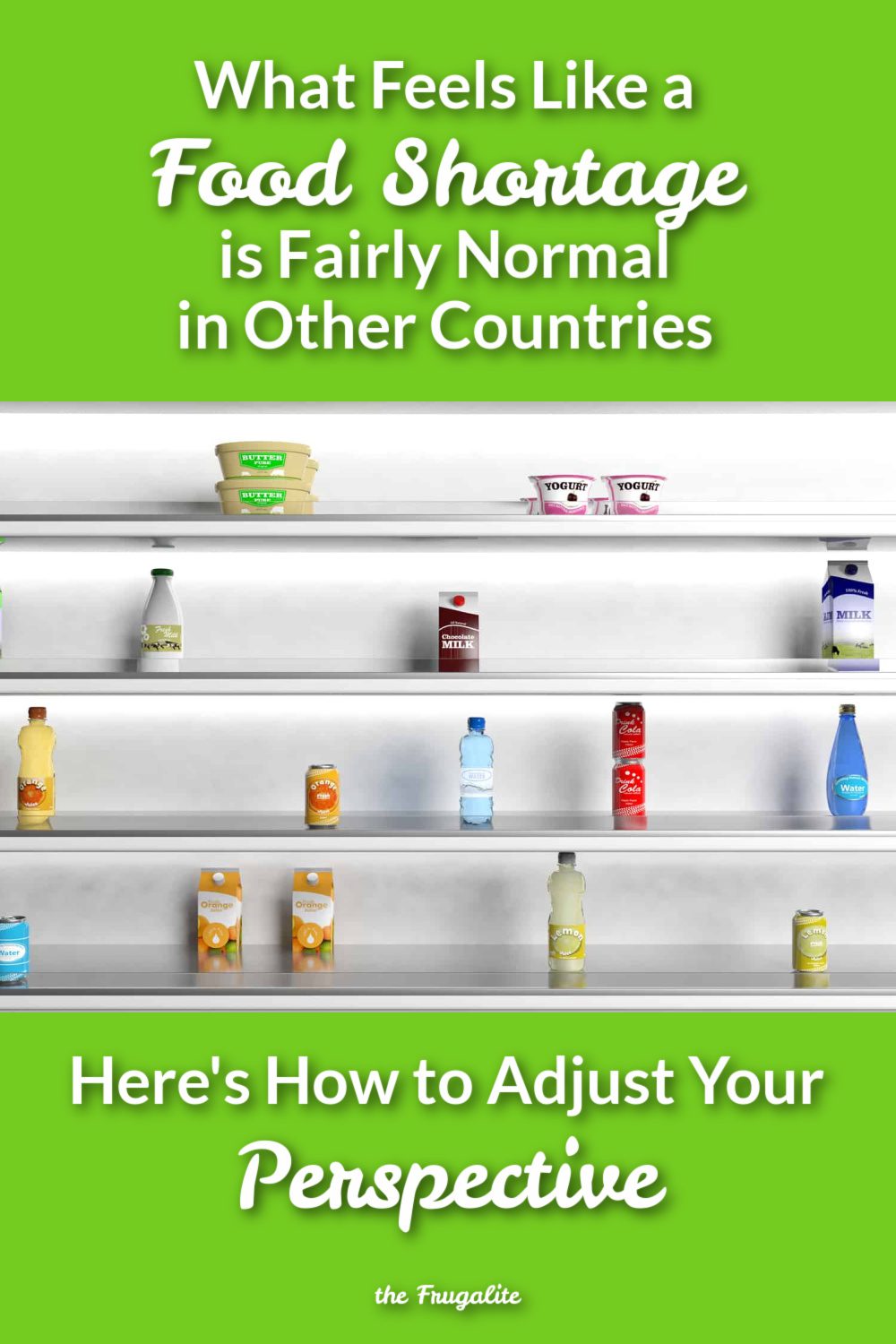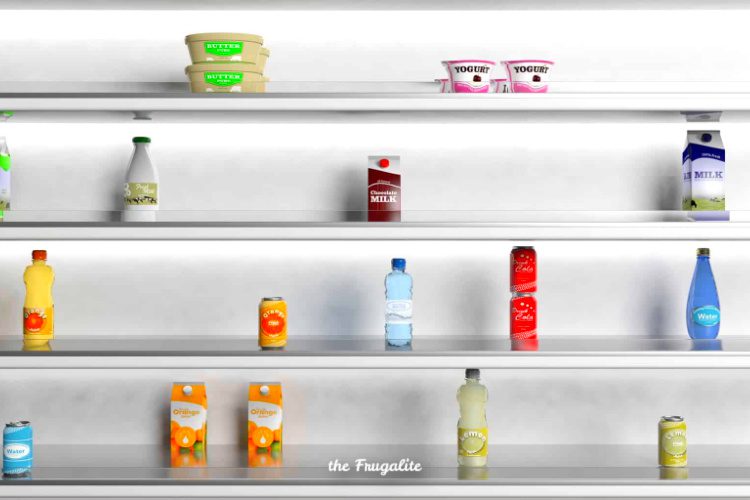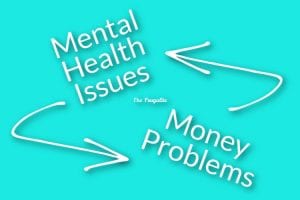(Psst: The FTC wants me to remind you that this website contains affiliate links. That means if you make a purchase from a link you click on, I might receive a small commission. This does not increase the price you’ll pay for that item nor does it decrease the awesomeness of the item. ~ Daisy)
Ever since last March, we’ve seen dramatic photos of bare shelves across the country. Initially, we were told it was just an issue with everyone panic-buying due to the lockdown and that those pesky preppers and hoarders were the cause of the whole mess.
But now, here we are, six months a year and a half later, and the shelves in many places are still empty. There are things that are becoming increasingly difficult to find. Electronics, bedding, certain kinds of clothing and shoes, and many types of food are still sparse, if available at all. A trip to Walmart or Target will give you a visual demonstration of what we used to get from China.
Some folks are beginning to become worried that this is permanent. And they just might be right. But here’s another perspective to consider for the bare shelves we’re seeing.
Let me first reinforce that I’m trying to tell anyone that there aren’t real supply chain issues. I’m simply trying to provide a different perspective on those issues so that we can continue to stock our pantries and do our shopping without feeling panic welling up inside of us.
Choices
One thing that skews our perspective a little bit is that we have been “the land of plenty” for so long. We’ve been spoiled for choice and surrounded by abundance, most of us for our entire lives. A trip to Walmart or a grocery store meant you could spend hours picking and choosing between 29 different brands of ranch salad dressing, dozens of sets of sheets for your bed, or 15 different cuts of beef, all in one stop.
But now, when you go into the store to grab new sheets for your bed, you may find you have an expanse of bare shelving and one or two lonely sheet sets from which to choose. The same holds true for many different products.
The thing we’re missing is choices. There are very few choices at our stores right now.
Many countries focus on specialty shops.
Over the past couple of years, I’ve spent many months living abroad, both in Europe and in Mexico. Most of my time away has been spent in Greece, some small countries in the Balkans, and Mexico. There are two major differences between shopping there and shopping in the pre-COVID United States.
First, in other countries, you see more specialty stores instead of behemoths like Walmart or Kroger.
When I lived in Greece for a few months, I had some regular rounds I made once I got the hang of shopping there. I bought my meat from the butcher shop, my fruits and veggies from a produce stand, my bread from the bakery, cheese from a cheese shop, and a dessert from the pastry shop. It was a pleasant outing to walk around and pick these things up. The shopkeepers loved to tell you that the mandarins in your hand came straight from the farm of an uncle in the eastern part of the country, or that they have their own farm specifically to provide the juicy heirloom tomatoes that you were looking for, or that a relative raised all the beef available in their shop and how that relative made things more special. The thing that stood out to me was how the owners and workers took great pride in their offerings. This is definitely not something you’ll see at your local Safeway.
As I spend time in more countries, I’ve seen that these kinds of specialty shops are very common outside the United States. This isn’t to say they don’t exist in the US – it’s just that most people like to buy food conveniently grouped into one big store. Of course, there were also grocery stores that sold a little bit of everything. This is where I’d go to pick up things like flour, toilet paper, dishwashing soap, and other basics. However, at these stores, the fresh products weren’t nearly as good as the ones from the specialty shops.
There are fewer choices outside the US.
The other thing I noticed was a reduced number of choices when I went to a bigger grocery store outside the United States.
Let’s take meat, for example. Here in the United States, our stores have a lengthy expanse with hundreds of packages of meat down one aisle of the store. Outside the United States (at least where I spent most of my time) you had a little corner with a couple of chilled cases of meat. In those cases you could find chicken in perhaps three forms – whole, cut up with bone-in, and chicken breasts. For beef, you might find a roast and ground meat. With pork, you might be able to get a tenderloin, a larger bone-in roast, and some pork chops.
Moving along to other sections of the store, produce is not a vast corner with 25% of the contents of the store. It was a small section and the options were fairly basic. You didn’t have 17 brands or types of potatoes from which to choose. You just had potatoes in general in a large bin where you reached in and bagged your own.
There was food, and plenty of it. It was just that you didn’t have 29 different brands of salad dressing. You didn’t have as much processed food. You had access to basics.
This isn’t the end of the world.
Our stores look positively barren here in the US right now. We see headlines blaring about “shortages.” Many stores are still limiting purchases of meat, toilet paper, and cleaning wipes to two per customer. All of these things add up to provoke an atmosphere of dread. People are panicking because it feels like there’s “nothing” at the store.
I get it because it really is unsettling to see those long, empty shelves. This is not what we’re used to seeing here in the land of plenty. Part of the issue is that our stores were designed to display vast abundance, and now that there are fewer choices, these stores look alarmingly empty.
But perhaps it isn’t quite as bad as it seems. Perhaps it is our perspective that needs to change. Perhaps we’ll just be doing things differently.
I see a lot of similarities to the way I was shopping outside the country. While it looks like our football-field-length meat counters are empty and that we’re running out of meat, note that there still is meat available. It just might not be in the form that you are accustomed. Maybe you are going to have to cut your own inexpensive roast into the form you wanted. Perhaps you should plan more recipes with the leftovers from your whole chicken.
If you need new sheets (maybe you have added a bed in a size you didn’t have before) you may have to modify sheets that are too big, or perhaps use a flat sheet carefully tucked on the bottom instead of the perfectly-sized fitted sheet. Maybe you can’t find a toaster but you can find a toaster oven – or even use the oven in your kitchen.
I’m by no means saying that our economy is just fine or that our supply chain is A-OK. There are some things that you can’t get ahold of for love or money, like yeast, for example. But at this point, as long as you have the money to make purchases, there are products there to purchase. You just have fewer options for each item you wish to purchase.
Think differently about shopping.
It’s hard to make the switch from being able to choose one item from 15 types of that item to only having one type of that item. This is true whether you’re talking about yarn, about bacon, or about grapes. But remember, you can still get these things. You’re just going to have to change how you shop.
Like with other things that relate to frugality, a lot of this is about mindset. It’s important to have a mindset of abundance and gratitude.
Your favorite brand of detergent isn’t there? Well, there are two kinds to choose from and the ingredients to make your own. Therefore, laundry soap is available.
You wanted to make beef stew but there’s no stew meat available? Grab an inexpensive cut of roast beef and either ask the butcher counter to cut it up for you or cut it up into stew meat yourself once you get home. Learn to debone a chicken and be sure to put those bones in the freezer to make some stock later on.
Really focus on those smaller businesses like the ones I mentioned outside the US – look for local butchers, farmers, produce stands, etc., for much of your shopping. The products you get will probably be fresher, healthier, and best of all, reliably supplied within season.
Shift your perspective
You can see what I mean – it’s all about perspective. You don’t see people in Europe panicking because they can only get beef in two forms at the grocery store or because there’s only one brand of canned beans. They just buy their beef and their beans and carry on.
There are a lot of things that are out of our control. We cannot personally influence trade agreements, the behavior of people on social media, or the scary headlines we see in the mainstream media. But we can control how we live our lives. People all over the world look at grocery store inventory like ours and find it perfectly normal. They feel there’s plenty for everyone and feel no panic.
We can tap into that.
All we need to do is change the way we’re looking at things.
- Shift your perspective from one of deprivation to one of continued abundance. (There is plenty of meat – I just need to cook it differently)
- Don’t look at those mostly empty cases and panic. (These stores were designed for enormous amounts of inventory.)
- Tap into your problem-solving skills. (A king-sized flat sheet tucks around the mattress of a queen-sized bed just fine.)
- Buy locally. Find other sources for the things you want or need, like local farmers or co-ops. (This boosts your local economy and gives you some important connections.)
- Produce what you can. (Even some herbs and greens in the windowsill will make a difference.)
- Learn to make do. If you can’t find what you believe you need, how can you adapt to that? Is it something you can do without? Is it something you can solve creatively?
And then, calmly proceed with your life.
Yes, we’re only at the beginning of our economic issues here in the US, but by adapting to these changes little by little, and seeing them as a challenge to our frugal skills, we’ll be just fine. We will be ahead of the curve and ready to meet the next challenge when it arrives.
What do you think?
What are your thoughts when you go to the store and can’t find the things you used to purchase? When you see the barren shelves? When you discover something is back ordered for 6 months? Let us know how you’re handling it in the comments.












40 thoughts on “What Feels Like a Food Shortage Is Fairly Normal in Other Countries. Here’s How to Adjust Your Perspective”
You’re trying to “calm the troops” The fact is…there are shortages. NH…Today…many, many, many empty shelves. Appears that panic buying to happening…people not taking “chances.”
Wal-M clerk “We’re only getting 75% of our orders. Why’s that?
I love this article. When we lower our expectations and are grateful for what we have, we are so much happier. We also become more creative and resilient. Thankyou for this perspective. It made my day!!
Thanks for the refreshing positive article. Gratitude & abundance attitude are so important. ❤️
This is an amazing article! Thank you for this perspective!
I recall when I first returned to Canada after nearly 4 years in rural Japan. I ended up in such a panic the first time I went to a grocery store, I ended up crying in the cereal aisle. The sheer volume of choices I had to make on a single shopping trip was so overwhelming, my brain simply could not process it and broke down. And I had grown up in Canada! It is just not normal to have to choose between 400 types of breakfast cereal! The same for other products. You could have fit 18 Japanese grocery stores into the single Superstore near my house. That was when I began to understand how crazy our way of shopping in North America is. Plus the crowds gave me panic attacks, the pushing, everyone being in such a hurry that I left the store a morass of bruises from people’s carts. And I missed the leisurely chats with the shopkeeper and the 2 or 3 other customers I would normally encounter in the fishmongers or fruit stall in Miyazaki. Our ways of shopping are dehumanizing and stressful. And time wasting. I would rather do my miles of walking outside in a park than among huge long fluorescent aisles of virtually identical foodstuffs. And since the pandemic disruptions began, I haven’t missed any meals or gone short of anything I really needed, I just look in different places for it.
I feel this. I lived in Spain for five years and went shopping everyday. Now the idea of even driving to the store seems rediculous to me. The bakery scene where I live now is an abomination, and the fruits and veggies are subpar and over priced. Even though I’ve been back for ten years now my mind won’t adjust cus I know there is better way!!
Daisy, we are spoiled in what we have. We as a family haven’t suffered as much as some. We haven’t run out of toilet paper or things like that. We haven’t always been able to get what we wanted, but we have what we need. We didn’t have a garden this year, but we got seeds for next year. I have jars and lids to can. I also have a dehydrator. Our freezer is full. We are lucky that we have all of these things. I’m grateful that we thought ahead.
Concentrate on stocking up on what’s available. Next week the shortages will move on to different items.
.
I can’t comment on what’s going on in other countries since it’s been quite some time since I was overseas.
My town in the in the western part of North Carolina is doing okay so far. I have seen things missing mostly ALCOHOL (the rubbing kind like you put on a bite), and CLOROX WIPES ARE SCARCE. I HAVE FOUND IT HARD AT TIMES TO BUY BABY WIPES. I CAN’T FIND AN HANDI-WIPES THAT I USE FOR WASHING DISHES LATELY…I HAVE SEEN THE BREAD AISLE WITH NOT NEARLY AS MUCH BREAD AS THEY USUALLY CARRY…PASTA, RICE AND CANNED SOUP TOOK A BIG HIT FOR AWHILE. I was in Walmart on Tuesday and there were stacks of carious food items sitting there waiting to be unloaded. Our store has been opening at 7 a.m. and closing at 8 p.m. lately and most of what goes on the shelves is done by stockers after it closes. They now have robots working in the back area to load up the rolling carts full of boxes of goods so that the actual LIVE workers can put them on the actual shelves at night…But for the most part we’re good so far, it’s not really been a problem for me yet. I also go to Ingles which is kinda expensive and upscale but when I was in there last week or week before last they had everything I needed and a lot more so no issues there either…
It may well get worse in the coming days or weeks but right now this part of N.C. is okay for the most part thankfully.
TYPO: VARIOUS FOODS, SORRY FOR THE MISPRINT…
Here, the supermarket shelves were empty but in our local shops just a few metres away was the fruit n veggies shop completely stocked, same as the bakery. Where I also asked if they could sell me flour and yeast and they happily do so and I buy the kids an occasional treat (cake ) from there. I found mostly the older Europeans shop this way keep these shops alive. For myself we shop their as the big chains are too bright and loud for my kiddos. They love the little stores where the shop keeper’s know their names and often save something on sale for us or give the kiddos a treat. Most is local and not effected by covid19 shortages. But others are now catching on too, these store which were quiet are now booming. Home shopping has been restored and most everything is back on the chain shelves including yeast . But I noticed some shopping habits have changed.
It would be interesting to know the how the inventory in larger grocery stores in, for example, the suburbs around Paris, France, or Berlin, Germany, compares to that found in comparable stores in Greece, the Balkan states, and Mexico. I’m guessing there might be more varieties of products available in those two countries that, presumably, have stronger economies.
I noticed the missing items seem to rotate or change into non standard brands.
Single items spaced out to fill empty spaces.
The TP section I looked at about 3 days ago was 16 bays 2 spaces in each bay 4’deep 4’high.
2/3 empty and for no reason.
Those same bays were empty for a couple weeks a while back, no shortage just hoarding.
Similar with water.. you get it? people freaking out over something they all have in mass quantity as much as they can tolerate as often as they want it.
But at the store it’s in magical plastic containers.
I dislike shopping at Aldi’s simply because they have less options, but they always have what I need.
Thinking about it some more.
In disaster stories I have read/listened to, water(in bottles) was always a high priority.
Same with TP, bullets, defensive weapons.
I wonder if fantasy is altering peoples better judgement.
Just an idea.
Trust your gut!!
I had a bad feeling back in early February when 5 million of the 14 million Wuhan residents slipped out of the city before they locked it down for covid.
The “escapees” were mostly the well heeled folks and of course, they jumped on international flights to ride out the storm. Australia, western europe, Canada and of course, AMERICA! And as Atlanta has the kargest busiest airport in the nation, i knew they were coming HERE….
I rotated out some older stock, ( got a little lazy in the Trump years lol) topped off all the chest freezers, and picked up more things for immediate use. Wife thought i was crazy and was stinkeyeing me watching all this money sailing out the door… Haha!
We were loaded to the hilt with fresh ammo orders, lots of TP and paper towels, had the septic tank and ac units serviced, 150 gallons of stored gasoline… Piles of new canned goods when they were still 2 for a buck and no purchase limits.
We were done a full 2 weeks BEFORE the panic set in, thankfully. And when the bottom finally fell out, the wife and family were SHOCKED….
Just a gut feeling….
I never 2nd guess my instincts any more. Looking back, the times i fell thru the floor? Were the times i IGNORED my gut, or tried to rationalize it away.
Many years ago back in the eighties, a friend of my fathers was working for a company in Russia. He met a young woman, married her, and brought her back to Canada. On her first grocery shopping trip he wanted to keep it simple – he knew it would be overwhelming for her. She was to get the coffee – he found he curled up on the floor crying. “Too many choices” in Russia there were only two choices: yes coffee was available, no coffee wasn’t available. She didn’t know there could be that many coffee choices in the whole world! In Canada, we have less product choices than you do in the United States. Any time I go down to the States I always spend at least one day at a big grocery store shopping – the range of choices is amazing. Instead of feeling deprived perhaps the brands left on the shelf are those that are made in the United States and everyone can show them some love and help keep their employees working.
I was at a local dollar tree and was appalled at the emptiness of the aisles. Since many of the products come from places other than China, this was a shock. When I say empty, I mean one box for the whole aisle. I looked at another shopper who was also staring at the emptiness and said “Gee they’re pretty well picked over, aren’t they?” She laughed and nodded.
I think the panic buying is starting up again in response to the “massive surge” in covid that MSM has been sounding the alarm about. That and there seems to be “issues” with the supply chain.
My mom was in Home Goods last week and the shelves were bare in some sections. She asked the cashier what was going on and she said, “We are waiting for shipments from overseas.” Thanks to Daisy’s articles, we were prepared in February/March (although we learned a lot) and are always continuing to prep. I have purchased my daughter’s next size up in some clothes, sneakers and books/craft supplies/learning toys and manipulatives as I am homeschooling her this year.
Dollar tree has been bare since the beginning of the pandemic.
There are many things we can’t get now. This may not be a problem for many, but with the food allergies in my family, those missing items may be some of the things that we can actually eat; like rice flour. Yes, we have been blessed with an abundance of goods in the past, and yes, we will have to learn to live with what we can get, but it isn’t always as easy as it sounds. We will do the best that we can, and find alternatives, because that is just the way it is now.
Hi, Michele – that would definitely make things far more challenging when you have serious food allergies.
I had run across this DIY a while back when looking for something different and had bookmarked it. It’s from an Indian cooking site and it’s how to make your own rice flour. It could be worth the investment in a grinder if you do not already have one, because I suspect with food allergies there could also be other things you might need to grind yourself. I hope this helps.
https://www.vegrecipesofindia.com/how-to-make-rice-flour-recipe/
Fantastic idea! You can use a coffee grinder to make flour if you have to – you can get those for $20 or so, hand crank or electric. Can also use a blender to grind things. Just a tip in case you don’t want to buy another appliance. 🙂
Can you buy rice and grind it in a food processor to make rice flour? Or even oat flour? Ive done it. Its pretty simple. Rice can be hard to find still, but any type will do for flour.
There is certainly good in being upbeat and optimistic but there is also good in being cautious and noting the warning signs.
A game came out in 2016 called We Happy Few. Probably one of the best written games I have ever seen. The plot is this: America did not join WWII, Germany won. The game is set in England in the 60s. The populace is drugged into a “happy” state which prevents them from noticing pesky problems like their food supply running out. Uncle Jack is a news anchor who is broadcast constantly telling people chipper things like how to eat grass to get that vitamin C.
I may be being too cynical but modern day Europe reminds me of that far too much.
As a side note, for the last oh, seven years now there has been a serious undercurrent in the gaming industry on simulator games solely focused on surviving. These are extremely punishing games based around survival and nothing else. Most important are probably Don’t Starve (2013), The Long Dark (2014), and Frostpunk (2018).
I find it interesting in the same way I found Pandemic 2 (2008) and Plague Inc (2012) interesting when they released. What made Pandemic 2 and Plague Inc so unique was that you:
A. Played as the virus trying to kill the world
B. Dealt with quarantines, lockdowns, airport restrictions, etc
C. Had to balance symptoms to spread massively before altering to a higher lethality. Didn’t want to burn out early afterall.
They pretty much laid the groundwork vis-a-vis millions of simulations (playthroughs) of what the most effective type of disease, dispersal, carriers, symptoms, release location, etc, etc would work.
*shrug* Coincidences are crazy these days…
I find this article inaccurate for most of France and Germany. Due to my travels the last six months, I had to purchase food in many areas of France. No changes in food supply in France and Germany. I have visited and shopped in several French cities and find no food shortages, in fact, the very opposite. For example due to Government misguided Covid-19 measures (restrictions) some farmers going out of business, because they couldn’t sell their products due to lack of demand. Also, my son who lives in Germany find no food shortages in Berlin, Munich or Frankfurt.
I think you may have misunderstood what I meant in the article. I’m not saying there are food shortages. I’m saying that in my experience, the stores in Europe carry fewer options than the stores in the United States to begin with. The norm there isn’t 400 different types of laundry soap or 70 different cuts of chicken. (Exaggerated numbers) – It’s 4-5 types of laundry soap and 3-4 cuts of chicken. It’s simply different choices, and as an American there, it’s a bit startling initially but you adapt quickly. I’m recommending people look at this as things are still available, you just may not have as many brands from which to choose.
And I bet the small, local shops will be the most eager to let me pay with my junk silver coins when the real crisis hits.
I think one of the problems we’re having is we’re so used to eating what we prefer. As a person who used to not eat beans, or most vegetables, or… I understand how difficult it is to walk into the store and discover they’re out of “what you eat.” When my income dropped suddenly I discovered food is food. It’s on your plate, and if you’re hungry you eat it. If you’re not hungry enough to eat it, wrap it up, put it away, and eventually you will be.
I understand about food allergies and kids with sensory issues, but the truth is most of us are accustomed to making a grocery list and buying what’s on it. Once you switch to making a list of categories instead of brands and certain items, shopping during supply disruptions gets easier. I need a protein, some carbs, some green vegetables, some orange vegetables, and some butter or margerine. Protein this week may be beans, lentils, chicken, fish or beef. Vegetables may be fresh, frozen or canned. When you shop this way you may end up with some things on your plate you normally wouldn’t eat, but these aren’t normal times. I suspect the next generation will be far less picky about food. If your plate is nutritionally balanced and you find a couple things your family really likes, you’ll get by and maybe even discover a few new foods you enjoy.
I know that different parts of USA have different disruptions. Florida had little disruption during covid compared to major shortages of everything in Michigan. Currently same is happening except the difference is that people have had opportunity to prepare because of knowing shortages possible/continue & financial support that has been given to many Americans. Unfortunately costs have skyrocketed 25% to 300+% on products. while I understand some reasoning I have difficulty with explanation of much given. If the USA did not learn during covid that we need to get back to making things in our country so that we are able to prevent future occurrences like this then I think that the few that are able to survive will look at things differently. I try very hard to be as frugal as possible & spend more on certain items for higher quality/last longer & continue to do best can with what have.
I do suggest that people start looking for American made—which is not much more expensive & invest in quality that will last longer than cheap made in china products. I honestly have most of my stuff is second/third hand/used & have had for years/decades. I have invested in products that can not find second hand but know will last years/decades if taken care of. only wish that had gotten few items that now will not be able to that will help as we navigate this uncertain times in our lives.
unfortunately for me/us it is also a major life change occurring & all my self sufficient ways have been removed & uncertain if will be able to do again in timely manner as it is truly necessary for the future.
I use a Mexican laundry powder. Really big bag , few bucks . I shop any deserts from the discount rack. I like the $3 + loaf of bread but I buy the $1 loaf or make something at home. I buy the generic veggies still as of last week holding at 50 cents each. I buy the cheapest meat I find, usually pork right now, and generic milk. Still eating fine.
A little ham or bacon is plenty diced in a bean or pea soup with some onion. Not going hungry.
Too many forget the fact that politicians of a certain ilk passed laws to let US companies move manufacturing overseas – lost jobs, lost tax revenue. Now the same politicians and their supporters are squealing like Ned Beatty in Deliverance – you know who you are. The US is still a long way away from those with money being unable to find and afford what they need/want. So my advice is this – ignore the red meat and wedge issues when it comes to voting. And do your due diligence and math when it comes to online purchasing. Studs Terkel – there is no such thing as a free lunch. Updated to today’s world – shipping is not free on Amazon.
This is so true regarding shipping.
We are looking into another printer for our books because we’d like to work with the little guy instead of giant corporations. The printer suggested that we build shipping costs into our price because due to “Amazon Prime” everyone refuses to pay for shipping now. Of course, having published through Amazon, I can tell you for a fact, that’s exactly what they do too. It shows us in the back end when we’re pricing our books.
Checked out our small Dollar Tree yesterday – well stocked. This store does not carry any food other than snacks.
Ordered TP and bar soap from WM – TP was cancelled due to internal supplier problems and soap’s delivery date was unknown. Ordered TP from Sam’s but was limited to 1 of their brand, ordered it twice with no problem. The second package will be split between neighbors
Ordered soap from Amazon with no delivery problem, it was not a major brand.
Local super WM is stocked but with the center of aisle free standing units gone, many shelves are single faced with product. However, the Neighborhood WM (has food, household, personal care and a pharmacy) is very well stocked at the moment.
.I think most of us have become used to always finding our favorite brands on the shelf and are having a difficult time changing. I’ve never had a problem with store brands but my neighbor refuses to even try them.
With increasing prices – locally it’s water/sewer, electric, taxes, gas up 24cents in 2 days, and then all the food – we are going to have to make changes whether we like it or not. Adaptation, resilience, positive state of mind will all be important over the next few years.
This go round we’re “short” of food items manufactured in the US. A large number of items, such as cream, are manufactured at the same plant. Of course name brands, such as Land-O-Lakes is available (likely in quarts) since it is the most profitable item. I’ve said it before – those with money won’t be as severely impacted at those on a budget/tight budget. See the organic prepper website for my opinion on supply chain/any issues (versus the knee jerk blame on the party and/or cabinet member you don’t like). This is the 1950s or even 60s/70s. The world has changed. Those who did not pay attention or cannot adapt will likely not survive.
I will not lower my expectations nor will I submit to mediocrity. Period. I will not be a subject. I am a free man.
Let’s Go Brandon!
It’s not about lowering your expectations. It’s about adapting and thriving. To me, that’s the epitome of freedom.
Prepare to be disappointed then. Unrealistic expectations lead to disappointment.
And as for “Brandon” he can go suck an egg.
First let me mention frugality: use it up, wear it out, make do or do without helps. Everything last longer so you simply don’t need to buy as much.
Second, and your stores may be different, but in my stores it is the convenience foods that are in low supply. The basics are still abundant and often even on sale! Flour, sugar, rice, dry beans, plain oatmeal in big tubs, the “boring” fresh veggies like potatoes, cabbage, beets, celery and turnips and less processed meats like whole chickens and larger cryo-vacced cuts of beef and pork are all readily available. For those of us that know how to cook and bake there is no shortage yet. The shortages are poptarts and frozen meals, all the overly processed convenience foods most Americans live on.
Third let me mention some unconventional retail options. I sell at a indoor, year round flea market. The variety of new and used goods available for purchase there is astounding and the prices amazing. I buy the large bottles of spices there for under $5 and brand name energy bars like Clif bars, still well within sell by date, for $1 a big box. Not only does the flea market sell food but new clothes, housewares, shoes and toys usually below what you would pay at a big box store. I sell new, name brand toys like Lego and Lol and I try to sell items below the big 3’s (Target, Walmart and Amazon) prices. I am also fully stocked up for fourth quarter and doubt I will run out of toys. So if you can’t get what you want at your big box store look around. Drug stores, office supply stores, ethnic markets, flea markets, scratch and dent stores and overstock stores like Big Lots all carry food and often other goods. These places are not usually anybody’s first thought when shopping so use that to your advantage.
And last shopping second hand stores is affordable and these stores usually have an abundance of goods. In our are the thrift stores also sell new products that I believe have been donated to them by companies in need of a tax write off.
In the wise word written on the cover of the Hitchhikers Guide to the Galaxy, “DON’T PANIC”. If you look you will find everything you need and most of what you want.
Amazing article
Nice